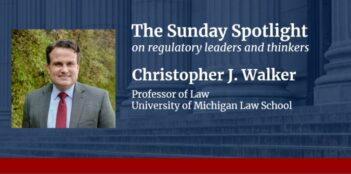
Scholar claims that advancing the public interest, engagement, and bureaucratic savvy make agencies great.
What constitutes excellence for regulators? According to one legal scholar, excellence requires that regulators do what President Theodore Roosevelt advised: keep “their eyes on the stars” and “their feet on the ground.”
In her chapter in the recent book Achieving Regulatory Excellence, Wendy Wagner, a professor at the University of Texas at Austin School of Law, argues that the best regulators possess three key qualities:
- “an unwavering commitment” to advancing the public interest at every stage of the regulatory process;
- dedication to seeking input from all parties affected by regulatory decisions; and
- an ability to navigate a “morass of regulatory procedures and requirements.”
To assess whether specific regulators achieve these qualities, policymakers and the public should use process-based measures rather than output-based measures, Wagner suggests.
She criticizes traditional output measures—which use a particular result to evaluate the quality and quantity of a regulator’s work—because they may force an agency to consider only one way to advance the public interest and thus prevent regulators from exploring innovative alternatives.
Output measures also may be influenced by external causes that fall outside the reach of a regulatory program. For instance, gauging regulatory success on the reduction of pollutants found in the environment neglects the possibility of pollution levels being affected by unregulated sources or natural variability. A regulatory authority might be condemned for “failing” even though the measured outputs stem from factors outside of its control.
Process-based measures—such as requiring agencies to construct an evidentiary and deliberative record which explains how their decisions best advance public welfare—more closely mirror Wagner’s three key qualities of excellence and better reflect how regulation should be implemented within a democracy, she writes.
To meet Wagner’s standards of regulatory excellence, regulators must first identify all interests and public considerations related to any regulatory decision. Sometimes this means taking special care to consider the interests of those who are not involved in the regulatory process, Wagner notes.
Low-income individuals may well have a substantial interest in a particular regulatory decision but will not have the resources to participate in the regulatory process. Even when public interest representatives comment on the public’s behalf, industry representatives vastly outnumber them and consequently can sometimes drown out those perspectives. To ensure that regulatory decisions take into account the full range of interests, agencies must often find ways to compensate for the lack of engagement by underrepresented groups, whether they are poor individuals, future generations, or the diffuse public.
According to Wagner, subsidizing underrepresented groups’ participation may best ensure that all relevant interests fully contribute. Regulators could also appoint external experts to advocate on behalf of such groups. They could engage in education and outreach initiatives to help potentially affected populations understand the impact of proposed rules.
In conjunction with ensuring full public engagement, excellent regulators must gather sound evidence when making decisions, Wagner argues. For science-intensive rules, for example, regulators should develop decision processes that ensure that information they rely on meets or exceeds accepted scientific reliability standards. Furthermore, agencies must adapt their programs when new information becomes available—such as when important changes occur in public attitudes, technology, or scientific techniques.
According to Wagner, the U.S. Environmental Protection Agency’s (EPA) process for setting ambient air quality standards provides a potentially good model. The EPA has typically offered multiple opportunities for public comment, involving the wider scholarly community by requesting literature reviews and soliciting frequent peer reviews.
Wagner encourages regulators to move swiftly to avoid “getting stuck in the muck.” They should keep in mind procedural roadblocks—for example, analytic requirements that force a regulator to evaluate tangentially related information of little value—and consider creative and innovative ways to streamline their work.
Wagner also notes that excellent regulators must remain aware of the larger political climate in which they operate without allowing politics to compromise their ability to advance the public interest. Indeed, regulators should even take advantage of political situations to advance the public interest, she says.
If a new president has made an issue a central campaign promise to address a particular regulatory problem, for example, agencies could prioritize rules that address that problem while a receptive administration is in office. But except in extreme circumstances, regulators should not be swayed by political pressures from elected officials when doing so would compromise public interest outcomes. And, if backroom negotiations do play a role in a regulatory decision, regulators should explain to the public how the political intervention influenced the outcome.
Wagner reiterates that the keys to achieving regulatory excellence lie in an “unwavering commitment to the public good, a grounded and rigorous decision process, and an ability to make progress regardless of context and circumstances.” Regulators must keep in mind basic process goals—such as engaging the most significantly affected groups—as their guiding star when formulating and carrying out regulatory policy.
This essay is part of a ten-part series, entitled In Pursuit of Regulatory Excellence.



